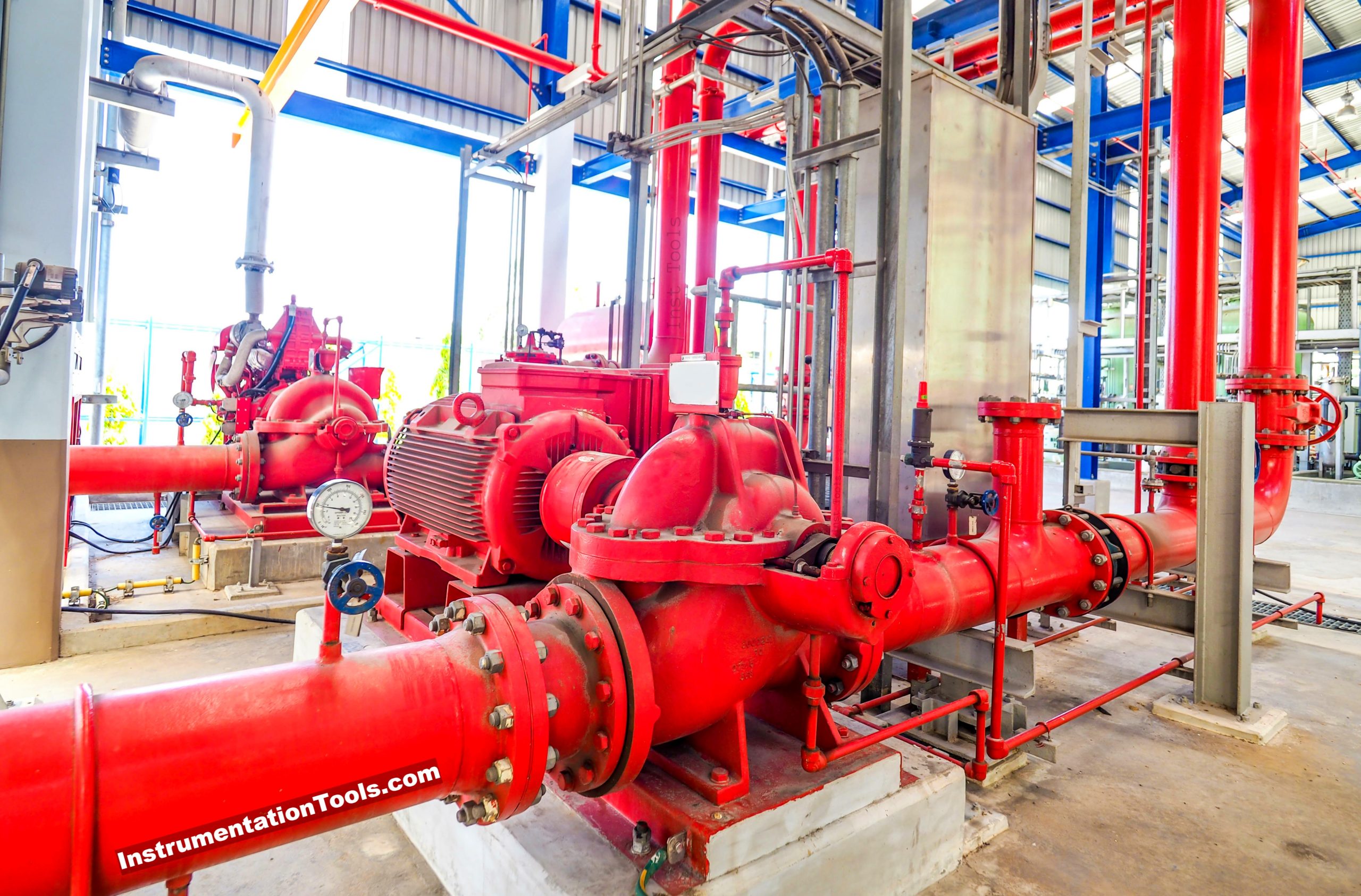In many high-rise buildings and commercial complexes, you must have seen big red color pipelines and pumps. Many imagine why it is colored red and why they are so huge in size. It is to be understood that these are fire pump systems.
In such establishments, it is usually not approved to live or work in them without these installations. This is because they quickly help in extinguishing fire in such high-rise towers before a fire fighter arrives. So, it is important that engineers and architects understand the working of this pump. In this post, we will see the working of a fire pump.
Fire Pump
A fire pump is a device that provides high-pressure water flow to fire sprinkler systems and fire hose standpipes in buildings or industries. A fire pump is used to ensure adequate water pressure and flow for firefighting systems.
Why is a fire pump required?
First of all, let us understand the importance of this pump. Generally, some buildings install pumps that are capable of throwing water up to the tallest floor and also handling fire systems like water sprinklers. These sprinklers get enough water pressure from these pumps and can extinguish the fire.
But, in many cases, the water pressure from the municipality (city water supply pipes) is not enough to boost the pressure required for sprinkler systems. It can supply normal water to taps and flush, but not create such a high jet pressure for extinguishing fire.
In that case, some boosting system must be required to boost the water pressure to a very high level and support firefighting. This purpose is thus achieved by fire pumps.

Fire Pump Principle
Now that we have understood its purpose, let us see how it works. As we have discussed, fire pumps work on the principle of generating very high pressure. There are two types of working methods for generating high pressure – centrifugal and positive displacement.
Centrifugal pumps operate on the principle of spinning water. Water enters the impeller and when the pump operates, a very high centrifugal force is applied to the water by rotating it. This creates a very high pressure and it is discharged to the load.
As the speed of the impeller increases to full, the rotation too increases and more water is thrown at the load required. Positive displacement pumps are similar to air compressors. They intake a small amount of water like compressors take a small amount of air at a time in their vessels.
Once the water is received, it is rotated at a high speed and pushed out of the pump at high pressure. Out of the two, the most used is a centrifugal pump, due to efficient flow rates maintained at high pressure.
These pumps work by sensing the pressure of the sprinkler system. When a fire occurs, the system is activated, and as much water as possible is thrown by it to extinguish. This water is taken from the municipality’s basic line.
So, when the pressure decreases due to demand, the fire pump senses this and comes into action by immediately pumping high-pressure water into the system.
Types of Fire Pumps
- Electric Fire Pump
- Diesel Fire Pump
- Vertical Turbine Fire Pump
- Jockey Pump
- Horizontal Split Case Fire Pump
- End Suction Fire Pump
- In-Line Fire Pump
Fire Pump Drivers
Any pump requires some source of power for operation. Fire pump also requires an energy source for operation and there are generally three types used – electrical, diesel engine, and steam turbine.
The most used is the electrical one. It is simple in operation as it just takes an electrical power supply and operates. Diesel engine fire pumps use diesel for combustion. When combustion occurs, the fuel is powered up and it operates.
Then, the least used one is the steaming turbine one. A separate mechanism like a boiler or steam generator is required to first generate steam and then the pumps use them to operate as the turbine is moved through steam.
Comparison of Fire Pumps
| Type of Fire Pump | Power Source | Operation | Installation | Use Case | Flow Rate |
|---|---|---|---|---|---|
| Electric Fire Pump | Electric motor | Automatic start on pressure drop or manual start | Indoors, typically in a pump room | High-rise buildings, commercial complexes | Varies, can handle high flow rates |
| Diesel Fire Pump | Diesel engine | Automatic start on power failure or pressure drop | Indoors or outdoors with weather protection | Areas with unreliable electric power, industrial facilities | Similar to electric, suitable for high flow rates |
| Vertical Turbine Pump | Electric or diesel | Manual or automatic operation | Installed in wells, lakes, or reservoirs | Areas without a reliable water supply at ground level | Depends on water source depth and motor capacity |
| Jockey Pump | Electric motor | Maintains system pressure to prevent unnecessary main pump operation | Installed alongside main fire pump | All types of fire pump installations | Low flow rate, not for firefighting but for pressure maintenance |
| Horizontal Split Case Pump | Electric or diesel | Automatic or manual operation | Indoors, requires more space | Large commercial or industrial facilities | High flow rates, efficient for high-pressure applications |
| End Suction Pump | Electric or diesel | Automatic or manual operation | Indoors, more compact design | Smaller facilities, less demanding applications | Moderate flow rates, less efficient than split case for high pressure |
If you liked this article, then please subscribe to our YouTube Channel for Electrical, Electronics, Instrumentation, PLC, and SCADA video tutorials.
You can also follow us on Facebook and Twitter to receive daily updates.
Read Next:
- What is a Fusible Plug?
- PLC Gas Detection System
- Heat Detector Testing Procedure
- Manual Call Point Test Procedure
- Ultrasonic Gas Leak Detectors
good